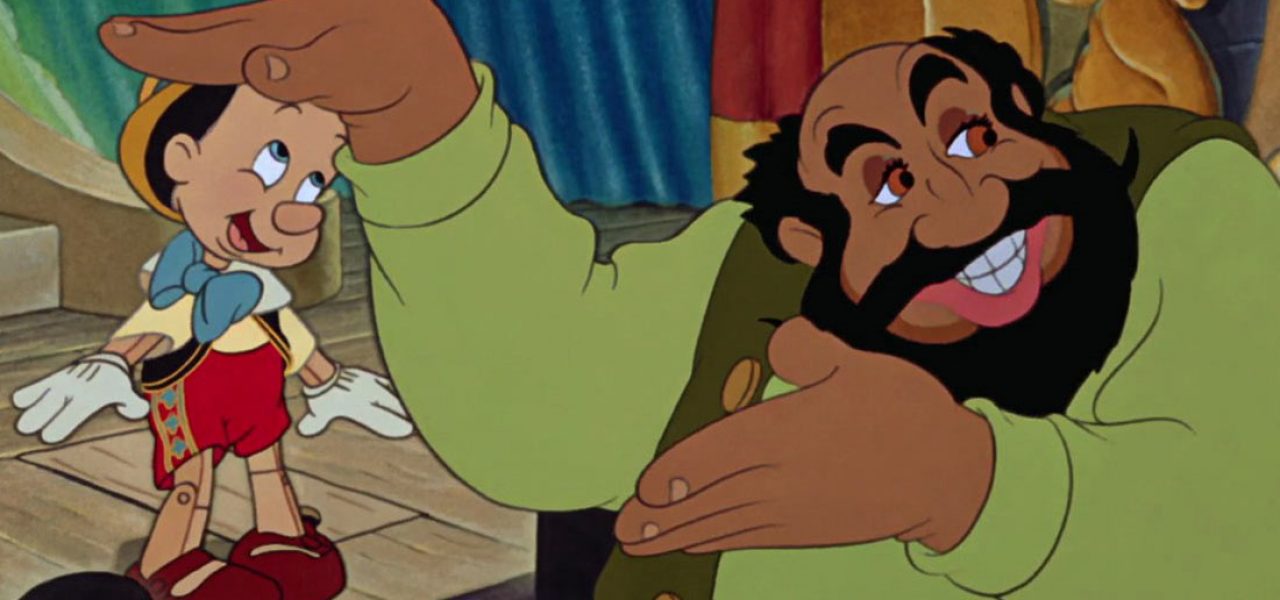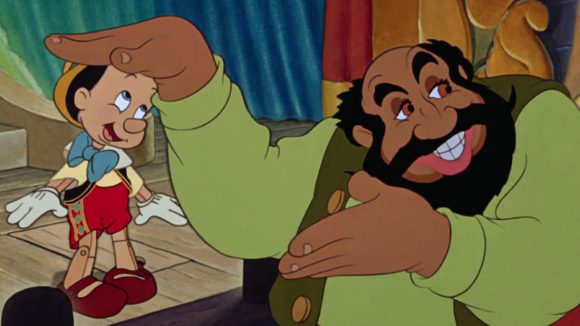

In Conversation: John Canemaker On The Disney Family Museum’s Massive ‘Pinocchio’ Exhibit
On May 18, an unprecedented exhibition dedicated to the Disney classic Pinocchio (1940) opened at the Walt Disney Family Museum in San Francisco.
The massive and rare collection of materials on display—over 300 objects from the production of the film—was curated by Disney historian and author John Canemaker, who has perhaps done more than any other single individual to educate contemporary audiences about the artistry of the classic Disney animation studio. Cartoon Brew spoke to Canemaker via e-mail about how he put together the exhibition and some of the exciting pieces that he uncovered for the show.
The exhibition, “Wish Upon a Star: The Art of Pinocchio,” will be on display at the Disney Family Museum in San Francisco’s Presidio park through January 9, 2017.

Cartoon Brew: How did the idea for the exhibit “Wish Upon a Star: The Art of Pinocchio” come about and how did you become involved with it?
John Canemaker: In May 2015, Kirsten Komoroske, executive director of the Walt Disney Family Museum, contacted me. The museum was planning a Pinocchio exhibition to open in May of 2016, and Kirsten asked me if I would curate it. I was immediately excited about the possibilities.
To many animation fans, Pinocchio is the epitome of the art of hand-drawn character animation, the crown jewel of Walt Disney’s first five masterful features. I saw an opportunity on a grand scale to fulfill a key mandate of Diane Disney Miller [1933-2013], the amazing visionary who co-founded the Walt Disney Family Museum. She wanted the museum to provide “educational experiences that honor Walt Disney’s legacy, and spark creativity and innovation in students, teaching professionals, and their families.”
My history with Diane goes back to 2000, when she asked me to appear in the documentary, The Man Behind the Myth. When she was planning The Walt Disney Family Museum, I was invited to be one of several animation historians who advised her and Rockwell Group, the project’s designers. Since the museum’s opening in 2009, I have lectured there on various topics, and I was guest curator of two exhibitions and author of two books for the Walt Disney Family Foundation that served as exhibition catalogues: Magic, Color, Flair – The World of Mary Blair and The Lost Notebook: Secrets of Walt Disney’s Movie Magic.

How did you organize the exhibit?
John Canemaker: I wanted to create for museum visitors the feeling that they are in the Walt Disney Studio, circa 1938, watching the production processes involved in the making of Pinocchio.
“Wish Upon A Star: The Art of Pinocchio” contains over 300 artworks and objects–including rough animation drawings, concept paintings, maquettes, a mock-up of a scene setup for the Horizontal Multiplane Camera, videos of documentary footage and pencil tests, photographs, recordings, and hands-on flipbooks. The exhibition offer museum-goers a truly immersive experience through each of the chronological phases of the film production’s pipeline.
It begins with Story, and comparisons of the original literary narrative with Disney’s adaptation and visualizations for the film. On display is an original 1911 deluxe storybook edition of the Carlo Collodi stories (first published in an 1881 Italian periodical), and we use blowups of the book’s lavish color illustrations by Attilio Mussino throughout the exhibition to demonstrate how Disney’s artists adapted or changed them completely. Original Disney story sketches, and blowups of sequences from full storyboards, fill most of the upper gallery.
The Design section contains seven gorgeous now-iconic concept paintings by famed freelance illustrator Gustaf Tenggren, and several drawings by the studio’s resident “inspirational sketch” artist, Albert Hurter, suggesting character designs, settings and props. Among the concept art are three unusual watercolors by Mique Nelson, who experimented with underwater background tests by scattering “salt and sugar, sodium sulphate and bromide of potassium” in patterns on wet paintings.
This section also shows the design evolution of three major characters: Jiminy Cricket, Geppetto, and Pinocchio. The development of the eponymous star’s personality, and his design–his change from a cruel brat as depicted in the books (he kills an unnamed cricket within the first few pages), into an appealing innocent on the movie screen–is fully revealed in drawings and test animation by various artists, most significantly the re-design by animator Milt Kahl.
A special room in the Design section is “Geppetto’s Workshop” which displays numerous three-dimensional plaster maquettes of each character, created by the Walt Disney Character Model Department. The room includes two versions of Monstro the Whale, a miniature of Stromboli’s puppet wagon used for rotoscoping, and a Pinocchio marionette.
The Layout section contains numerous drawings that determine the basic composition of a scene for the animators. Layout artists have been described as “the director’s arm on the visualization of the film.”

In the Animation section of the exhibition, we have original sequential drawings on the walls by several animators, e.g., Vladimir Tytla, Milt Kahl, Frank Thomas, Ollie Johnston, Art Babbitt, Ward Kimball, Eric Larson, Don Lusk, John Lounsbery, Norman Ferguson, Jack Campbell, Charles Nichols, Wolfgang Reitherman, and effects animator Art Palmer. On nearby video consoles are a select number of pencil tests made from full, rough animation scenes, copies of which are also available to museum-goers to manipulate as large-size flipbooks. (We used a special paper for the flipbooks that cannot be torn or damaged.) There are also video interviews with some of the film’s creators and documentary footage from 1939.
The Ink and Paint Department and the Background Department are showcased in a stunning display of original cels and matching backgrounds.
And finally, completing the production pipeline, is a scene set-up specially made for the exhibition by the Walt Disney Animation Research Library (ARL): a miniature reproduction of the jury-rigged Universal Horizontal Multiplane Camera, demonstrating how levels of painted glass plates and cels offered an illusion of depth to the photography of many Pinocchio scenes.
Where do the materials for the show come from? Did you have trouble locating anything that you wanted to include in the exhibit?
John Canemaker: Actually, we had more material than we could use. Though the exhibition is located in the two-story, two-thousand-square-foot Diane Disney Miller Exhibition Hall–a few steps from the Walt Disney Family Museum’s main building within the Presidio– it was necessary for me to cut nearly 100 artworks and artifacts from the exhibition because we ran out of space. So, we had no trouble finding material.
The bulk of the artworks and objet d’art came from the collection of the Walt Disney Family Foundation. Among the generous private lenders who responded to our requests for artworks are Tony Anselmo, Andreas Deja, Mike and Jeanne Glad, Don Hahn, The Mickelson Family, Ted Thomas, Jennifer Miller-Goff, and Joanna Miller.
We also had enthusiastic cooperation from the Walt Disney Studio: the good folks at the Walt Disney Archives, Walt Disney Photo Department, and Walt Disney Animation Research Library were wonderfully supportive in providing numerous rarities.
At the Walt Disney Family Museum, it was my great fortune to work closely with four extraordinary, dedicated and creative individuals: Michael Labrie, director of collections and exhibitions; art conservator Tonja Morris; manager of audio-visual John Stroh; and exhibition designer Marina Villar Delgado.
We became a long-distance family, communicating via tons of emails, Xeroxes, Fedex packages, and several two-hour Skype calls. Ron Miller, president of the Walt Disney Family Foundation, and the Miller Family, and Kirsten Komoroske were incredibly supportive of our efforts. It was a great creative experience.

Talk about a few of the objects or items on display that will be a surprise even for the most fervent fans of the film?
John Canemaker: I do think the seven Tenggren paintings are spectacular, and it is rare to see so many of them on display at one time, available for close inspection. I don’t think that has happened since the paintings were made in the Disney studio in 1938. They are beautiful conceptions, redolent of the atmosphere of Old World/other worldliness captured in the film.
I am also thrilled that visitors can hear a 1939 voice recording of Frank Thomas (at age 27), recently discovered on acetate discs and preserved by his son, Ted Thomas. The recording may have been an audio instructional “memo” that was distributed to other animators and assistants working on the boy/puppet Pinocchio. An excerpt of the recording is in Frank’s section of the exhibition containing his drawings.
The recording is, as Ted says, “a damn good example of Frank’s thought process and the amazing care and analysis that went into the realization of Pinocchio’s personality and movement.”
Here’s a taste of Thomas’ memo from 1939:
“We must make a delicate compromise between what we know is good smooth animation and what actually happens to jointed pieces of wood. The size and length of the different parts of his body cannot be changed to get the exaggerations we have used in other characters. And we would never stretch one of his joints. I don’t think we need to worry about getting him too stiff, because we have spent years using smooth animation and it will be very easy to loosen him up later should it be necessary.”

Did you have any new revelations about Pinocchio as you were putting the show together?
John Canemaker: It is interesting to me that within such a precise production structure, how fluid and intuitive the process was at every stage of development, but especially in pre-production. Due to difficulties with the story and the main character, time out was taken to change direction and make adjustments. Walt stopped animation for about six months while the personality and design of the boy-puppet was re-considered. We show these changes in the exhibition.
“Wish Upon a Star: The Art of Pinocchio” will be on display at the Walt Disney Family Museum in San Francisco through January 9, 2017. For museum hours and admission prices, visit the museum web site.

.png)